Marine Birds
Mingan Archipelago National Park Reserve
The Mingan Archipelago National Park Reserve is home to thousands of marine birds during their breeding and migration period. Many of these marine bird species nest on the islands and are periodically surveyed and numbered as part of the Reserve's Ecological Integrity Monitoring Program (EIMP), in order to determine the health status of the populations.
In order to ensure the reproductive success of these birds, certain islands or sectors of the islands are closed to public during the nesting period. This reduction of disturbances promotes reproduction and increases the chances of survival of young and adult birds.
| Group | Nesting | Non-nesting |
|---|---|---|
| Alcids | Black guillemot |
Thick-billed murre |
| Laridae | Herring gull |
Iceland gull |
| Anatidae | Common eider | |
| Phalacrocoracidae | Double-crested cormorant | Great cormorant |
Alcidae
The alcids are a group of small pelagic marine birds that can dive and swim underwater with their wings. Of the six nesting and non-nesting alcid species that frequent the shore and rocky cliffs of the Mingan Archipelago National Park Reserve, three are being monitored under the Ecological Integrity Monitoring Program.
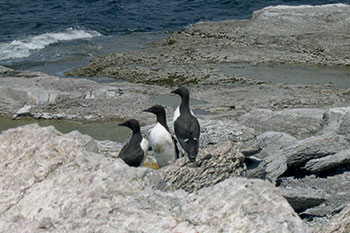
The Common murre spends a great part of its life at sea. It is capable of propelling itself underwater by flapping its wings to reach depths of up to 100 metres, allowing it to attack shoal of fish from underneath. In May and June, several pairs of Common murres choose the coastal rocky cliffs of the Mingan Archipelago National Park Reserve to lay their only egg on the rocks. Both parents feed the chick, but it is only with the father that the young, still unable to fly, swims to perform its first autumnal migration.
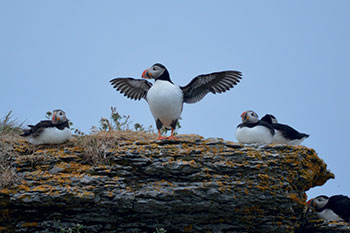
Locally known as "Sea parrot" or "Clown of the sea", Atlantic Puffins gather at the Mingan Archipelago National Park Reserve in April-May to breed and nest. They first form social rafts on the water before engaging in love parades near the burrows located on the coastal cliffs. Only one egg is laid per couple, and both parents will feed their young. The latter consumes the equivalent of its own weight in food each day in order to acquire enough energy to follow its parents at sea in the fall.
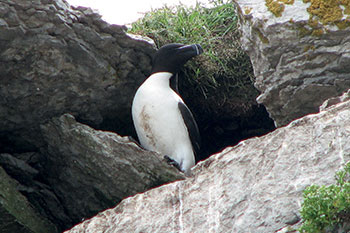
True to their nesting sites, the Razobill pairs arrive in the park reserve in April-May to form small nesting colonies along rocky shores or coastal cliffs. Both parents take care of their only chick all summer, sometimes diving up to 15 metres deep to fetch food. It is very important to avoid disturbances in the colonies during their stay at the Mingan Archipelago National Park Reserve, so that adults and young are ready to leave for their winter quarters in September.
Laridae
Laridae is a group of marine or coastal birds with webbed feet that feed at the surface of the water or in shallow waters. Of the ten species of nesting and non-nesting populations on the shoreline and cliffs of the Mingan Archipelago National Park Reserve, five are being monitored under the Ecological Integrity Monitoring Program.
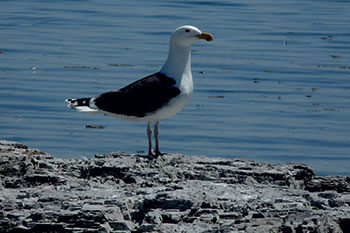
Great black-backed gulls and Herring gulls are migratory birds that arrive in the park reserve in March. They eat everything, including eggs and chicks from other bird species. Although both species can be found on shores and coastal cliffs, Herring gulls sometimes also nest in peat bogs, in the barrens or at the top of conifers in the boreal forest. The Herring gull leaves the park reserve in August, while the Great black-backed gull stays until the end of the fall.
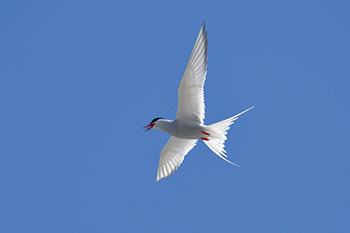
Locally known as "Sea-swallows", Common and Arctic terns visit the Mingan Archipelago National Park Reserve from May to September to feed on fish and crustaceans. During this period, the pairs build rudimentary nests on the ground or on the vegetation, and lay from 1 to 4 eggs. Terns are very sensitive to disturbance and can become territorial during the nesting season, so it is important to stay away from nesting colonies.
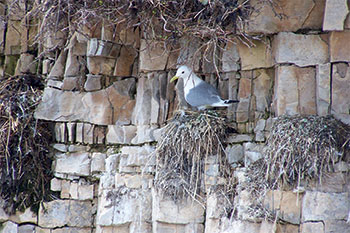
The Black-legged kittiwake is usually found at sea and only frequents coastal cliffs during nesting periods. Several pairs gather in the Mingan Archipelago National Park Reserve in April to nest and feed on the fish, crustaceans, molluscs and plankton that they catch while swimming underwater. They return at sea in the fall.
Anatidae
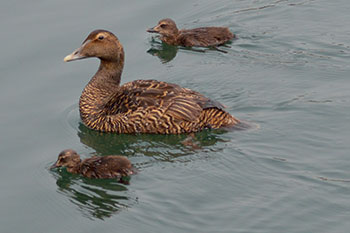
Nearly 30 species of nesting and non-nesting waterfowl frequent the freshwater and coastal waters of the Mingan Archipelago National Park Reserve. Among them are several species of harlequins, geese, ducks, eiders, coots, bluebills, golden-eyes, mergansers, scoters, loons and teals that benefit from the wide variety of food available in the park reserve. The Common eider, however, is the only marine diving duck species monitored under the Ecological Integrity Monitoring Program. Locally known as "moyak", the Common eiders of the subspecies dresseri gather in April to nest on the wooded and grassy islands of the Mingan Archipelago, while those of the borealis subspecies are just passing through to feed during their overwintering stay. Once the eggs are laid, the dresseri females stop feeding during the incubation period while the males leave the park reserve for the moulting areas. Highly vulnerable to disturbance and predation, females and ducklings remain together in the park reserve until fall, forming a family rafts on the water called "creches", allowing them better protection during feeding time.
Phalacrocoracidae
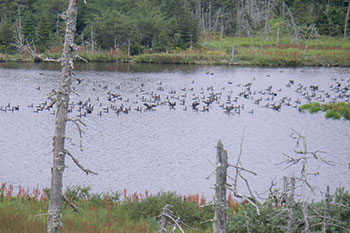
Phalacrocoracidae is a group of large aquatic birds that use their webbed feet and wings to propel themselves underwater. Two species are present on the islands of the Mingan Archipelago National Park Reserve, but only the Double-crested cormorant is monitored under the Ecological Integrity Monitoring Program.
Double-crested cormorants arrive in the park reserve in April-May to build their nests on the forested islands, coastal cliffs or bare islands of the archipelago. Being excellent fishers, both parents will take turns to feed their young with fish, crustaceans and molluscs. Double-crested cormorant colonies established in trees of the boreal forest can impact canopy vegetation through their droppings that drip from nests and accumulate on the ground. In the fall, adults and juveniles leave the park reserve to begin their southern migration.
Other pelagic groups
Several other non-nesting pelagic birds such as boobies, fulmars, jaegers, stormpetrels and shearwaters will enjoy the rich waters surrounding the islands of the Mingan Archipelago National Park Reserve as a feeding ground during their winter migrations.
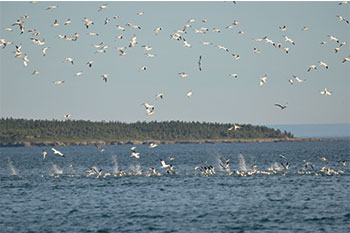
The Northern gannet, an occasional visitor, is one of the most noticeable bird during its summer visit to the Mingan Archipelago National Park Reserve. Following the movement of shoals of fish, Northern gannets gather in large numbers and use the momentum of their vertical dives to move underwater and capture their prey. This dive can be done from a height of 40 metres in the air to reach depths of 10 to 15 metres under water. Once satiated, Northern gannets leave the park in the fall to return to the south.
Related links
- Date modified :